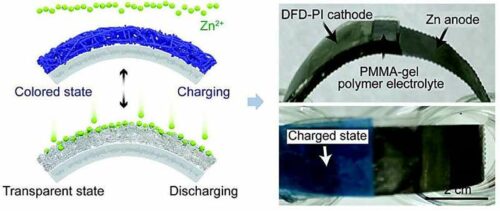In the fast-growing smart gadget market, researchers introduce an electrochromic Zn-ion battery, promising revolutionary advancements in energy storage and potential applications in smart windows and wearable technologies, reshaping energy use and conservation strategies.

Amid the swift expansion of the market for smart and wearable electronic gadgets, there is a burgeoning interest in advanced energy storage systems that store energy and feature colour-altering characteristics. The electrical conductivity of current electrochromic devices falls short, resulting in compromised electron and ion mobility and inadequate storage capacities. Consequently, the application of these batteries has been restricted within the realm of flexible and wearable devices.
A collaborative research group, spearheaded by Professor Il-Doo Kim of the KAIST Department of Materials Science and Engineering (DMSE) and Professor Tae Gwang Yun from the Myongji University’s Department of Materials Science and Engineering, has unveiled the creation of an t electrochromic Zn-ion battery. This battery can visually display its charging and discharging cycles thanks to an electrochromic polymer anode that integrates a “π-bridge spacer.” This inclusion enhances the efficiency of electron and ion mobility.
Batteries with electrochromic features can visually illustrate their charged and discharged statuses through colour alterations. These can also serve as display apparatuses that reduce energy usage for indoor temperature moderation by managing solar absorption. The researchers adeptly constructed a flexible and electrochromic smart Zn-ion battery that sustains its electrochromic and electrochemical attributes, even when subjected to prolonged exposure to atmospheric conditions and mechanical distortions. The group conceptualised and created the world’s inaugural polymer anode with an integrated π-bridge spacer to optimise the electron and ion mobility efficiency. The π-bonds can amplify the internal electron mobility within a configuration, facilitating accelerated ion transitions and enhancing ion absorption efficacy, thereby augmenting its energy storage potential.
In batteries with an anode fortified with a π-bridge spacer, the spacer facilitates more rapid ion transit, paving the way for swift charging cycles. This culminates in an enhanced zinc-ion discharge capacity of 110 mAh/g, marking a 40% improvement over earlier records and a 30% enhancement in electrochromic functionality. This functionality transitions from a dark blue hue to a transparent state during the charging and discharging phases of the device.
If this transparent flexible battery technology were implemented in smart windows, they could showcase darker hues throughout the day while harnessing solar energy. This would represent a forward-thinking energy storage approach capable of filtering UV rays and potentially supplanting traditional curtains.
Professor Il-Doo Kim remarked, “We have engineered a polymer amalgamated with a π-bridge spacer, culminating in the successful construction of a smart Zn-ion battery characterised by remarkable electrochromic efficiency and substantial energy storage capacity.” He further noted, “This methodology transcends the current paradigm of batteries utilised merely as repositories of energy. We anticipate this technology fostering a new era of energy storage systems that spearhead advancements in smart battery and wearable technology sectors.”






